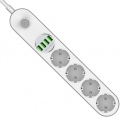Operation indicator
The presence in the design of the surge protector of a special indicator (usually in the form of a light bulb) that indicates that the device is turned on.
This function provides the presence of at least one common indicator; and on models with switches per outlet (see below), additional indicators can be installed on the outlets. Anyway, such equipment makes working with the surge protector more visual, allowing you to immediately assess the status of the device and avoid some unpleasant situations (for example, imaginary equipment breakdowns — when a “faulty” device does not work just because the filter is not turned on).
The indicator can be installed directly in the switch (general or for each outlet, see the relevant paragraphs for details).
Grounded sockets (type F)
The number of
sockets with type F grounding, provided in the design of the mains filter.
In this case, we are talking about full-size European type F sockets with metal ground clamps on both sides at the edges of the socket. The "socket" in this case means a CEE 7/4 ("Schuko") standard plug. Grounding is required for the safe operation of some types of electrical appliances, in particular, washing machines and other machines that work with water, refrigerators, computers, audio equipment, etc. A detailed list can be found in the reference literature. If you plan to connect such devices through the filter, this filter must have sockets with grounding.
International plug
The number of
universal sockets in the filter, compatible with several types of plugs at once.
Most often, such sockets are made compatible with three types of plugs: a standard “Euro plug” used in Europe and the post-Soviet space, an American Type A plug (two parallel flat contacts) and a Type I plug used in China and Australia (three flat contacts at an angle ). The filter for international plugs is useful for those cases when the household has equipment with different types of plugs — it will allow you to do without additional adapters.
Power (with 1 device)
The maximum power that a USB port can produce when connecting only one gadget.
Higher power output speeds up the charging process. At the same time, there are a number of nuances associated with this parameter. Firstly, the appropriate power must be supported not only by the port, but also by the gadget being charged - otherwise the speed of the process will be limited by the characteristics of the gadget. Secondly, to take full advantage of the capabilities, you may need to support not only the appropriate charging power, but also a specific fast charging technology. Thirdly, in filters with several charging connectors, the maximum power per device can only be achieved if the other ports are not used.
Charge current
Current value for all USB ports of the device. Allows you to understand how much maximum you can squeeze out of the device, i.e. how much current will be supplied to each port at maximum load. As for the maximum value of the current strength, it cannot be determined by this indicator.
Safety socket cover
The presence
of protective shutters from children in the design of the surge protector.
Such curtains are shutters that cover the current-carrying parts of the outlet and restrict access to foreign objects (most often, curious children try to put such objects into the outlet — hence the name). The design of the dampers is most often such that they open only under the pressure of the plug, when two contacts press on the curtains at the same time.
Socket plugs
Placement of plugs in sockets of an extension cord or surge protector relative to the device case.
-
at an angle. Seats with holes for plugs in such models are rotated at an angle of about 45 ° relative to the plane of the case. Such an option for placing plugs allows for convenient inclusion of plugs so that they do not interfere with each other and do not overlap adjacent slots.
—
Parallel to the body (180°). The holes for the plugs in this layout are arranged in sockets parallel to the body of the extension cord or surge protector. Large plugs are included in them perpendicularly, i.e. at an angle of 90° from the side of the "tail" with a network cable in relation to the axis of the device body.
—
Perpendicular to the body (90°). A fairly rare form factor that involves the placement of seats for a plug with a plug perpendicular to the axis of the device case. As a rule, openings at an angle of 90 ° relative to the housing are found in models for compact flat plugs and in surge protectors of atypical form factor. They can also coexist with sockets where the holes for the plugs are located at an angle.
- At an angle and parallel to the body. Combined variant of the layout of the holes for the plug, combining sockets with seating at an angle and parallel to the axis of the body of the extension cord or surge protector.
- At an
...angle and perpendicular to the body. A variety of network filters and extension cords with different arrangements of holes in the mounting sockets. Most of them are placed at an angle with respect to the axis of the body, and one or more - perpendicular.
